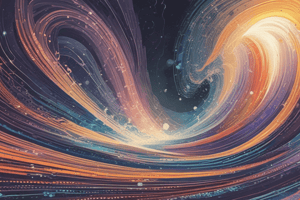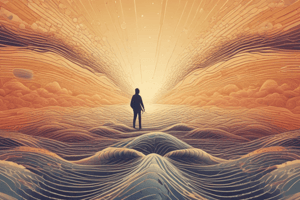Podcast
Questions and Answers
Flashcards are hidden until you start studying
Study Notes
Nature of Light
- Debate on light's nature: wave vs. particle theories persisted for centuries.
- Isaac Newton favored the particle theory, believing light travels in straight lines and couldn’t propagate in a vacuum.
- Christian Huygens opposed, explaining wave-related phenomena like fuzzy shadows due to wave interactions.
- The Double Slit Experiment by Christopher Young confirmed waves prevailed by creating diffraction patterns.
- Albert Einstein revived particle theory through the photoelectric effect, showing electrons are ejected based on light's frequency, not intensity.
- Light exhibits wave-particle duality, incorporating properties of both particles and waves.
- Louis de Broglie extended duality to all particles with mass.
Properties of Light
- Important properties include intensity (brightness), direction, frequency (color), and polarization.
- Investigated lab phenomena include straight-line travel of light, reflection from mirrors, and color production.
Reflection and Refraction
- Reflection occurs when light bounces off reflective surfaces; characterized by the law of reflection (incident angle equals reflected angle).
- Refraction is the bending of light as it transitions between different media, affected by the density of those media.
Lenses
- Lenses are optical devices that use refraction to form images, categorized into convex and concave lenses.
- Convex lenses focus light rays to a point, enabling applications in telescopes and microscopes.
- Concave lenses disperse light rays, used in corrective eyeglasses for nearsightedness.
- Ray diagrams illustrate image characteristics using three principal ray paths, defining real vs. virtual image concepts.
Diffraction
- Diffraction involves the spreading of light as it passes through an aperture or around obstacles.
- Patterns of light and dark areas arise from constructive (peaks overlap) and destructive (peak meets trough) interference.
- Diffraction patterns can be observed through slits comparable to light's wavelength.
Electromagnetic Waves
- Light is classified as an electromagnetic wave with specific frequencies determining color.
- Higher frequency waves appear blue, while lower frequency waves appear red; color-filter experiments illustrate this principle.
Electric Current
- Electric current results from the flow of free electrons, measured in amperes; exists as direct current (DC) with fixed direction or alternating current (AC) which varies over time.
- In electrolytes, current arises from charged ions; in gases, from ionization.
Electric Circuits
- Circuits form complete loops allowing electron flow; components act as resistors, consuming energy.
- Resistance decreases current, illustrated by Ohm’s law, which states current varies inversely with resistance.
Voltage and Power Sources
- Voltage is the electrical energy provided to circuits, initiated by sources like batteries or generators converting various energy types.
- OHM’s law related resistance, current, and voltage, revealing their interdependence.
Circuit Types
- Series circuits connect components in one path, splitting voltage while maintaining consistent current.
- Parallel circuits allow current division among branches with equal voltage across each.
Conductors and Insulators
- Conductors permit free current flow; examples include copper and salt water.
- Insulators block current, with materials like rubber and plastic.
Electrical Resistance
- Resistance opposes current flow, measured in ohms; affected by length, cross-sectional area, and temperature of conductors.
- Joule's law explains energy conversion to heat in resistive components.
Voltage Concept
- Voltage indicates potential work from charged particles, analogous to pressure in a system.
- Charge density influences voltage, expressed in joules per coulomb (volts).
Studying That Suits You
Use AI to generate personalized quizzes and flashcards to suit your learning preferences.




